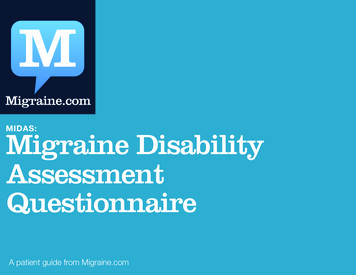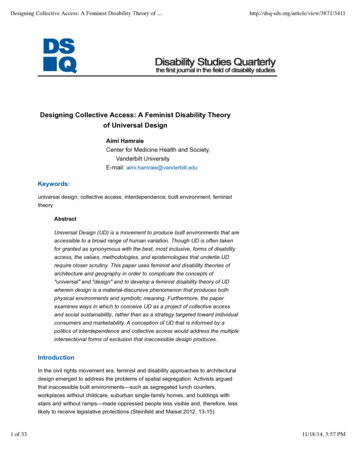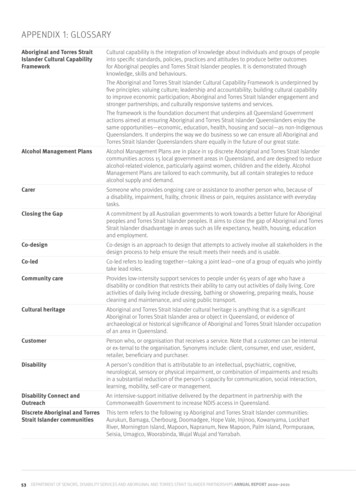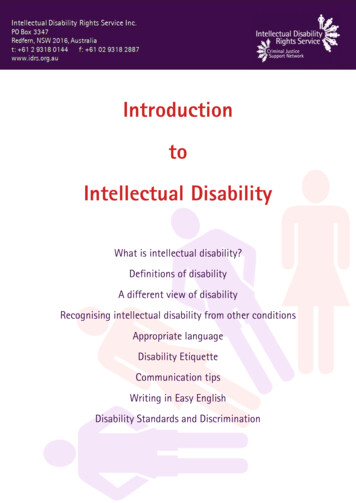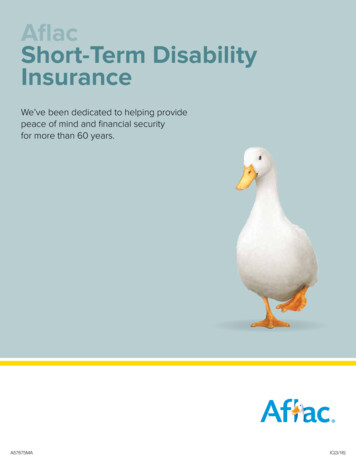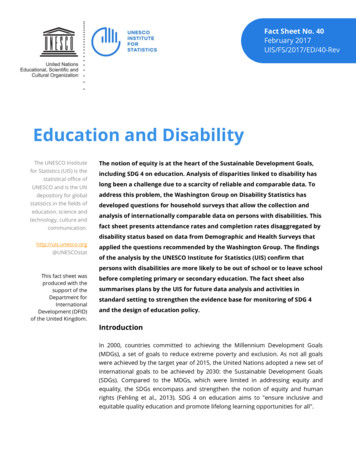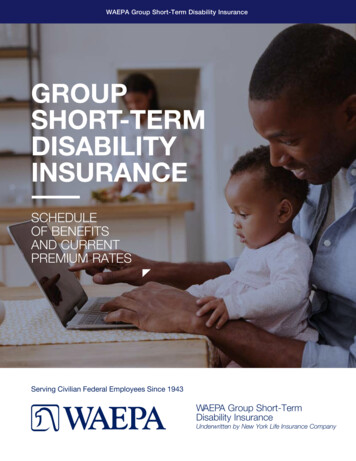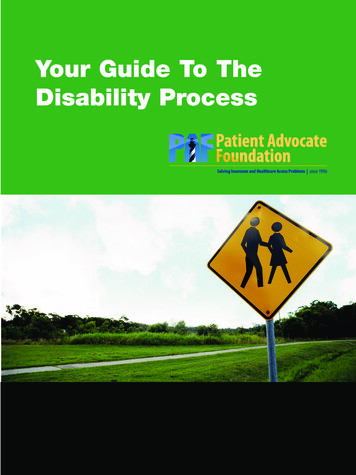
Transcription
Your Guide To TheDisability Process
The Patient Advocate Foundation is a national non-profit organization that serves as an active liaison betweenthe patient and their insurer, employer and/or creditors to resolve insurance, job retention, and/or debtcrisis matters relative to their diagnosis through case managers and attorneys. Patient Advocate Foundation seeksto safeguard patients through effective mediation assuring access to care, maintenance of employment andpreservation of their financial stability.Patient Advocate Foundation offers direct patient services through our toll-free number and website.National Toll-Free Number: 1 (800) 532-5274Phone Number: (757) 873-6668700 Thimble Shoals Blvd.Suite 200Newport News, VA 23606Fax: (757) 873-8999E-mail: info@patientadvocate.orgInternet: http://www.patientadvocate.orgFirst Edition, 2004 Patient Advocate Foundation.All rights reserved, including the right of reproduction in whole or in part in any form.Manufactured in the United States of America.
Your Guide To TheDisability Process
ACKNOWLEDGEMENTSYour Guide to the Disability Process has been prepared by the Patient Advocate Foundation, a nationalnetwork for healthcare reform and patient services located in Hampton, Virginia.Patient Advocate Foundation would like to acknowledge the U.S. Department of Labor, the SocialSecurity Administration and the Centers for Medicare and Medicaid for providing guidance throughlocal and national resources, websites and publications. The following resources provided invaluableinformation for this publication:U.S. Department of Labor, “Compliance Guide to the Family Medical Leave Act”, www.dol.govSocial Security Administration “Understanding the Benefits”; “Disability Benefits”; and “Medicare”,www.ssa.govCenters for Medicare and Medicaid, “Medicare and Other Health Benefits: Your Guide to Who Pays First”;www.cms.gov and www.medicare.govThe Patient Advocate Foundation’s “National Financial Resource Guide”; “The Managed Care AnswerGuide, Second Edition 2004”; “Your Guide to the Appeals Process”; “Greater Understanding Brochure Series”;www.patientadvocate.orgNancy Davenport-Ennis, EditorPresident and CEOPatient Advocate Foundation andNational Patient Advocate FoundationPrincipal Writing:Contributing Writer:Beth Darnley,Executive Vice President, Patient and Public RelationsPatient Advocate FoundationMarianne Smith, Esq.Contributing Researcher:Sandy Shook, LPNSenior Case Manager, Director Internet Patient ServicesPatient Advocate FoundationErin MoarattySenior Case ManagerPatient Advocate FoundationJennifer Risk, BA SociologyManager of Regional Operations & In House EducationPatient Advocate FoundationContributing Editors:Jacqueline Beard, BA Social WorkCase ManagerPatient Advocate FoundationDonna McQuistian, RN, OCNVice President of Patient ServicesPatient Advocate FoundationDeirdre O’Reilly Marblestone, Esq.Legal Case ManagerPatient Advocate FoundationAaron MarshallExecutive Vice President ofInformational TechnologyPatient Advocate FoundationGreg BakerWeb Development ManagerPatient Advocate Foundation
TABLE OF CONTENTSIntroduction . 6Chapter 1 - Short Term and Long Term Disability . 7Chapter 2 - Social Security Disability .10Chapter 3 - Health Insurance Issues Before and After Medicare .13Chapter 4 - The Appeals Process . 20Chapter 5 - Financial Assistance . 22Important Numbers. 27Bibliography. . 313
DISABILITY ENTITLEMENTS TIMELINE (UNINSURED)Date of Diagnosisor out of work File FMLA with employer if applicable1 week Complete physician visits and follow ups Gather medical and financial documents Apply for indigent drug programs2 weeksFile for Medicaid, Social Security Disability Benefits andSocial Services assistance45 days Uninsured patients check status of Social Security DisabilityBenefits and Medicaid applications Contact PAF if denied or no response2 monthsExpedited SSI payments for terminally ill patients may begin3 monthsFMLA protection ends5 monthsSSDI waiting period ends for approved patients and payments begin*24 month Medicare waiting period begins12 monthsMust have medical certification of disability that prevents patientfrom working for 12 consecutive months to qualify for SocialSecurity Disability29 monthsSSDI recipients become eligible for Medicare4
If "deemed" disabled by SSA within the first 60 days of COBRA,patient is eligible for 11 month extension of coverage.DISABILITY ENTITLEMENTS TIMELINE (INSURED)Date of Diagnosisor out of work Check insurance policies for providers and benefitsFile FMLA with employerFile STD applicationCOBRA may be offered1 week Complete physician visits and follow ups Gather medical and financial documents2 weeks Most STD payments begin Apply for Social Security Disability benefits45 days COBRA election due if eligible Check status of Social Security Disability application Contact PAF if claim denied2 months Notify insurer of COBRA extension File LTD application3 monthsFMLA protection endsLTD payments may begin5 monthsSSDI waiting period ends for approved patients and payments begin*24 month Medicare waiting period begins12 monthsMust have medical certification of disability that prevents patientfrom working for 12 consecutive months to qualify for SocialSecurity Disability18 monthsCOBRA ends unless eligible for extension24 monthsLTD ends for certain diagnoses29 monthsSSDI recipients become eligible for Medicare and need to choosea Medi-Gap plan36 monthsCOBRA extension ends5
INTRODUCTIONThis guide was written in response to the many issues that have been identified by the Patient AdvocateFoundation, as they have assisted patients who were faced with disabilities and subsequent access difficulties. Many of those patients would have benefited from the information contained in a comprehensiveguide to navigating the overwhelming process of filing for Disability benefits. Whether you are filing aclaim through an insurance policy or through the Social Security Administration, the process is rife withred tape and confusion. PAF feels that the more information you have, the more capable you will be tomake decisions that can ultimately impact your long-term insurability and financial stability. It is ourhope that Your Guide to the Disability Process will provide you with the necessary tools to anticipate thesteps you need to take to make your disability claim problem free.There are five chapters in Your Guide to the Disability Process:Chapter 1 – Short Term and Long Term DisabilityThis chapter describes the differences between Short Term and Long Termpolicies and how to understand how they work and what you need to domaximize your benefits.Chapter 2 – Social Security DisabilityThis chapter describes the Social Security Disability process and the differencebetween the programs offered by Social Security. Tips on filing and what youneed to do are included.Chapter 3 – Health Insurance Issues Before and After MedicareThis chapter explains Medicare and Medicaid eligibility issues disabledpatients often have. It also contains guidance for disabled patients enrolled ingroup health insurance programs.Chapter 4 – Appeals ProcessThis chapter addresses the process through which you can file an appealshould your claim be denied.Chapter 5 – Financial ResourcesThis chapter lists resources that can assist disabled patients with health carealternatives and financial assistance.6
CHAPTER 1SHORT TERM AND LONG TERM DISABILITYMany working adults are enrolled in programs or have insurance policies that protect their income in theevent a disease or medical condition prevents them from engaging in gainful employment. Disabilityinsurance can be obtained through an employer group program or purchased as an individual policy.DISTINCTION BETWEEN INDIVIDUAL AND GROUP POLICIESDisability insurance is intended to replace income lost due to a medical disability. This coverage may bepurchased by individuals on their own “individual policy,” or provided as a benefit by employers at no orlow cost to employees “group policy.” Income replacement benefits paid under a group policy are taxable.Benefits paid under an individual policy are not taxable, under the rationale that the policy premiumswere totally paid with after-tax dollars. Adequate income protection should include both an STD andLTD policy. Your STD policy should match the length of the LTD waiting period to ensure there is nolapse in coverage.Every plan is different. Policy language governs.Read your contract. SHORT TERM DISABILITY (STD)Group PlansA typical group policy will pay short term disability benefits for 90-180 days. Sometimes these benefitsare funded and administered by an insurer and sometimes funded by the employer and administered by athird party administrator. The employer is usually very involved with the short term disability claim.The plan usually will pay 60-100% of pre-disability income, depending on the policy. A cap on benefits iscommon – for example, a plan may pay 60% of salary up to a maximum salary of 50,000.00 per year, ormay declare a maximum benefit of 500.00 per week. Certain conditions may be excluded from coverage,or coverage may be limited – for example, a disability that is the result of a pre-existing condition maynot be covered until the employee has been covered by the plan for 12-24 months. Disability resultingfrom elective surgery is a common exclusion.STD plans are usually more lenient than LTD plans in the type of medical documentation that needs tobe submitted to support the claim, since the length of the claim is limited to 90-180 days. It is almostalways necessary for the employee to be under the care of a doctor who will provide satisfactoryevidence of disability. Policy language usually states that an employee may receive STD benefits ifmedically unable to perform his or her usual job.Income from other sources usually offsets STD benefits – for example, workers’ compensation wage lossbenefits. Since workers’ compensation pays 66% of pre-disability earnings, no STD benefits may bepayable.7
Individual PlansShort term disability policies are not typically purchased on an individual basis. Individuals instead purchase long term disability insurance through an insurance company and the individual deals directly withthe insurance company. LONG TERM DISABILITY (LTD)Group PlansLarge employers may self-insure and self-administer these plans, but it is much more common for aninsurer to be the sole administrator of the claim, and for the requirements for proof of disability to bemore stringent. For this reason, it is not unusual for an employee to receive STD benefits for themaximum period and then be abruptly denied LTD benefits. Patients must apply for their LTD benefits.STD benefits do not automatically roll-over into LTD benefits.Most group LTD plans pay 60-80% of pre-disability earnings for a specified period of years or until age65. In order to qualify for benefits detailed medical information must be provided to the LTD carrierat the onset of the claim and periodically throughout the life of the claim as requested. Failure to doso results in denial or termination of benefits.Usually there is a 60-180 day elimination or waiting period following the onset of disability to qualifyfor benefits. STD policies are usually written to provide benefits during the waiting period of an LTDpolicy. It is a good idea to have both an STD and LTD policy. Your STD policy should be for the samelength of time that your LTD policy elimination or waiting period is. Check your policies to ensure thatwhen the STD plan benefits end that the LTD benefits would begin.Certain conditions may be excluded or limited as discussed above in the STD section. Often the policywill limit coverage for so-called “mental-nervous” conditions to a maximum or 24 months. Policylanguage governs and there is much variation from plan to plan.Most policies have two definitions of disability –“Own Occupation” and “Any Occupation.”During the “Own Occupation” period, benefits are payable if the employee is unable to perform his orher regular job or a similar job. The Own Occupation period is at the beginning of the claim and isusually two years in length. After that, benefits are payable only if the employee is unable to perform anyoccupation.During the “Any Occupation” period, benefits are only payable if an employee is unable to performany occupation for which he or she is or becomes reasonably fitted by education, training or experience.Some policies state that if the employee is unable to perform work that pays at least 60-80% of pre-disability earnings, the person will be considered disabled, while others do not take earning potentialinto account. Income from other sources offsets LTD benefits. For this reason, most LTD carriers requireclaimants to file for Social Security Disability as soon as possible. Often the LTD carrier will payattorney’s fees for the employee who is represented by an attorney at the hearing level.Some LTD carriers assign rehabilitation professionals to try to help the employee transition back to work.Failure to cooperate with rehabilitation usually results in termination of benefits. Some carriers willcontinue to pay full or partial LTD benefits for a specified period of time while the employee is returningto work.8
Individual PoliciesIndividual LTD policies are available from insurance carriers and can be tailored to the individual’s needs.The benefits payable are generally a percentage of pre-disability earnings as evidenced by income taxreturns. Premiums and coverages vary greatly, depending on the age, health and usual occupation of theindividual. The same general principles are applied for the policies as outlined above. APPEALSIt is important to consult the plan summary or policy to determine how to appeal a denied claim and tofile appeals in a timely manner. Most policies do make allowances for late appeals if an individual isincapacitated or is otherwise unable to file an appeal. Please refer to Chapter 4 of this publication forguidance on filing an appeal if your claim is denied. STATE SPONSORED DISABILITY PROGRAMSThere are some states that offer state sponsored disability income protection for state residents. Theseprograms are state-mandated and funded through employee payroll deductions. They provide short-termwage-replacement benefits to eligible workers who experience a loss in wages when they are unable towork for a NON-WORK RELATED illness, injury or medically disabling condition. Residents of statesthat offer these programs should contact their State Department of Labor or Employment for moreinformation.9
CHAPTER 2SOCIAL SECURITY DISABILITYHow does the Social Security Administration (SSA) Define Disability?According to the Social Security Act, the definition of disability is the “inability to engage in anysubstantial or gainful activity by reason of any medically determinable physical or mental impairmentwhich can be expected to result in death or has lasted or can be expected to last for a continuous periodof not less than 12 month”(www.ssa.gov).Social Security Disability Insurance (SSDI)SSDI is a federal disability insurance program designed for individuals who have worked enough to earnsufficient “work credits.” Under this program, monthly payments are based on the individual’s earningrecord, which is on file with the Social Security Administration. SSDI provides monthly cash benefitsand Medicare entitlement to those who are blind or disabled.SSDI benefits can be paid retroactive back to the original date of a disability, if a claim was filed at thattime. If you do not have enough work credits to qualify for SSDI then you maybe eligible for SSI.Supplemental Security Income (SSI)SSI is federal financial assistance program which provides monthly payments to individuals who eithernever worked or have insufficient credits on their earnings record to qualify for SSDI. SSI recipients aretypically required to have limited financial resources and assets that do not exceed 2,000 for one personand 3,000 for a couple. In 2004, the basic SSI benefit program will pay according to Federal PovertyGuidelines which are re-calculated each fiscal year.These programs are administered by the Social Security Administration and the disability criteriaare the same for both. In order to qualify for SSI or SSDI, an individual must have impairment or acombination of impairments that preclude substantial gainful work activity that is expected to lastcontinuous period of 12 months or longer or that is expected to result in death.Each individual who applies for SSDI is also screened for SSI benefits. SSI payments may be availableduring the usual 5-month waiting period before SSDI cash benefits begin. Benefits become payable themonth after the application is filed regardless of when the disability began. There is no retroactivebenefit under SSI. Those eligible for SSI may also be automatically eligible for Medicaid benefits. Forthose who receive SSDI approval, they will begin receiving monthly cash benefits after five full months ofwaiting.The SSA can make a determination of “presumptive disability” for SSI benefits. Presumptive Disabilityallows SSA to pay up to six months of SSI payments before they make their disability determination,based on the finding that there is a high probability that the applicant is disabled. SSA does not providefor presumptive payments to individuals applying for SSDI benefits (www.alsa-stl.org).10
The SSA has an expedited procedure for processing terminally ill cases to ensure that a favorable decisioncan be made expeditiously. The code word for this type of case is “TERI” case. This type of case needsto be flagged or noted some way by the claim representative so that the case can move expeditiously tothe Disability Determination Section (DDS). There is no cash benefits paid to the family if the claimantexpires during the waiting period or while a disability decision is being established. Theindividual’s medical records or pathology report must reflect that the claimant is terminally ill or about toexpire in six months or less (www.alsa.stl.org). THE DISABILITY PROCESSMost Social Security disability claims are initially processed through a network of local Social SecurityAdministration (SSA) field offices and State agencies called Disability Determination Services (DDS).The field offices obtain applications for disability benefits in person, by telephone, by mail or by filingonline. The application and related forms ask for a description of the claimant’s impairment(s),treatment sources and other information related to alleged disability. The field office is responsible forverifying non-medical eligibility requirements, which may include age, employment, marital status orSocial Security coverage information. The field office then sends the case to the DDS for evaluation ofdisability.The DDS office is fully funded by the Federal Government, but the State agency is responsible fordeveloping medical evidence criteria and rendering the initial determination as to whether or not aclaimant is disabled or blind under the law , the DDS tries to obtain evidence from the claimant’s own medical source first. If that evidenceis unavailable or insufficient to make a determination, the DDS will arrange for a ConsultativeExamination (CE) to obtain additional information needed. After, all the medical evidence is compiled,the Adjudicator/Claims Examiner is the person that makes the disability decision, and he/she determinesif the claimant will be approved or denied. Then, the DDS returns the case to the field office forappropriate action. If the DDS found the claimant to be disabled, SSA computes the benefit amountand will began paying cash benefits to the claimant.DDS takes into account the age, education and work experience of the claimant in addition to the medical records and the residual functional capacity to determine whether the claimant is “disabled” underthe SSA’s rules.It is much more likely that a claimant over age 55 will be approved for SSDI/SSI because it is assumedthat a claimant over age 55 cannot adjust or be retrained to a completely different line of work. HOW DO YOU FILE YOUR DISABILITY CLAIM?If you become disabled, you should file for disability benefits right away. You can do this by calling orvisiting your local Social Security office. There are federal government listings in your local phone bookor you can call a toll free number from any where in the United States by calling 1-800-772-1213 or ifyou have access to the internet by visiting Social Security Online at www.ssa.gov.11
You can shorten the time it takes to process your claim if you have the following medical vocationalinformation when you apply: Medical records from your doctors, therapists, hospitals, clinics, and caseworkers Your laboratory and test results The names, addresses, phone and fax numbers of your doctors, clinics and hospitals The names of all medications you are taking The names of your employers and job duties for the last 15 years Submit a copy of your most recent tax return along with a recent pay check stub A letter from your attending physician that includes this phrase as written:“.will be unable to work for 12 months or longer”Be aware that many disability applications, up to 60% of all filed, are denied the first time. Do not giveup! You have the right to appeal this denial and can do so very effectively with the proper medicaldocumentation(s) such as: physician’s notes, history and physicals, consultations, MRI’s, cat scans andpathology reports. Include other pertinent information that would indicate a decline in your condition aswell as any side effects to medications (memory loss, fatigue, nausea, etc.). Do not file a new applicationafter a denial, appeal the original decision. THE APPEALS PROCESSIf you wish to appeal, you must make your request in writing within 60 days from the date you receiveyour SSA denial letter. Please refer to Chapter 4 - The Appeals Process for more information.12
CHAPTER 3HEALTH INSURANCE ISSUES BEFORE AND AFTER MEDICAREOnce you are approved for SSDI, it is very important that you consider your health insurance optionscarefully before and after becoming eligible for Medicare. Once you have been receiving SSDI paymentsfor 24 months you will become eligible for Medicare.WHAT ARE MY HEALTH INSURANCE OPTIONSBEFORE I AM ELIGIBLE FOR MEDICARE? FAMILY MEDICAL LEAVE ACT (FMLA)FMLA entitles eligible employees to take up to 12 weeks of unpaid, job-protected leave in a 12-monthperiod for specified family and medical reasons. The employer may elect to use the calendar year, a fixed12-month leave or fiscal year, or a 12-month period prior to or after the commencement of leave as the12-month period. For more information on this Federal Law visit the Department of Labor website atwww.dol.gov.FMLA applies to all: Public agencies, including state, local and federal employers, local educationagencies (schools)Private-sector employers who employed 50 or more employees in 20 or moreworkweeks in the current or preceding calendarTo be eligible for FMLA benefits, an employee must: work for a covered employerhave worked for the employer for a total of 12 monthshave worked at least 1,250 hours over the previous 12 monthswork at a location in the United States or in any territory or possession of the United Stateswhere at least 50 employees are employed by the employer within 75 milesA covered employer must grant an eligible employee up to a total of 12 work weeks of unpaid leaveduring any 12-month period for one or more of the following reasons: For the birth and care of the newborn child of the employeeFor placement with the employee of a son or daughter for adoption or foster careTo care for an immediate family member (spouse, child, or parent) with a serioushealth conditionTo take medical leave when the employee is unable to work because of a serioushealth conditionUnder some circumstances, employees may take FMLA leave intermittently — which means taking leavein blocks of time, or by reducing their normal weekly or daily work schedule. Also, subject to certainconditions, employees or employers may choose to use accrued paid leave (such as sick or vacation leave)to cover some or all of the FMLA leave.13
The employer is responsible for designating if an employee’s use of paid leave counts as FMLA leave,based on information from the employee.A covered employer is required to maintain group health insurance coverage for an employee on FMLAleave whenever such insurance was provided before the leave was taken and on the same terms as if theemployee had continued to work. If applicable, arrangements will need to be made for employees to paytheir share of health insurance premiums while on leave.Upon return from FMLA leave, an employee must be restored to the employee’s original job, or to anequivalent job with equivalent pay, benefits and other terms and conditions of employment.Employees seeking to use FMLA leave are required to provide 30-day advance notice of the need to takeFMLA leave when the need is foreseeable and such notice is practicable.Employers may also require employees to provide: Medical certification supporting the need for leave due to a serious health conditionaffecting the employee or an immediate family memberSecond or third medical opinions (at the employer’s expense) and periodic recertificationPeriodic reports during FMLA leave regarding the employee’s status and intent toreturn to workWhen intermittent leave is needed to care for an immediate family member or the employee’s own illness,and is for planned medical treatment, the employee must try to schedule treatment so as not to undulydisrupt the employer’s operation. Covered employers must post a notice approved by the Secretary ofLabor explaining rights.It is unlawful for any employer to interfere with, restrain or deny the exercise of any right provided byFMLA. It is also unlawful for an employer to discharge or discriminate against any individual for opposing any practice, or because of involvement in any proceeding, related to FMLA.(Compliance Guide to the Family and Medical Leave Act, U.S. Department of Labor EmploymentStandards Administration Wage and Hour Division, WH Publication 1421, December 1996) THE CONSOLIDATED OMNIBUS BUDGET RECONCILIATION ACT(COBRA)The Consolidated Omnibus Budget Reconciliation Act (COBRA) contains provisions giving certainformer employees, retirees, spouses, former spouses and dependent children the right to temporarycontinuation of health coverage at group rates. Group health coverage is usually more expensive thanhealth coverage for active employees, since usually the employer pays a part of the premium for activeemployees while COBRA participants generally pay the entire premium themselves. It is ordinarily lessexpensive than individual health coverage.Who is entitled to benefits under COBRA?There are three elements to qualifying for COBRA benefits. COBRA establishes specific criteria forplans, qualified beneficiaries and qualifying events.14
Plan CoverageGroup health plans for employers with 20 or more employees on more than 50 percent of its typicalbusiness days in the previous calendar year are subject to COBRA. Both full and part-time employees arecounted to determine whether a plan is subject to COBRA.Qualified BeneficiariesA qualified beneficiary generally is an individual covered by a group health plan on the day before aqualifying event who is an employee, the employee’s spouse or an employee’s dependent child. In certaincases, a retired employee, the retired employee’s spouse and the retired employee’s dependent children maybe qualified beneficiaries. In addition, any child born to or placed for adoption with a covered employeeduring the period of COBRA coverage is considered a qualified beneficiary. Agents, independentcontractors and directors who participate in the group health plan may also be qualifiedbeneficiaries.Qualifying EventsQualifying events are certain events that would cause an individual to lose health coverage. The followingare defined as “qualifying events:” Voluntary or involuntary termination of employment for reasons otherthan “gross misconduct”Reduction in the number of hours of employmentThe qualifying events for spouses are: Voluntary or involuntary termination of employment for reasons other than“gross misconduct”Reduction in the hours of employment worked by the covered employeeDivorce or legal separation of the covered employeeDeath of the covered employeeThe qualifying events for dependent children are the same as for the spouse with one addition: Loss of “dependent child” status under the plan rules(U.S. Department of Labor, Pension and Welfare Benefits Administration, www.dol.gov.pwba, “FrequentlyAsked Questions”)Special rules for disabled individuals and certain family members may extend the maximum periods ofcoverage. If a qualified beneficiary is determined to be disabled under the Social Security Ac
Patient Advocate Foundation offers direct patient services through our toll-free number and website. National Toll-Free Number:1 (800) 532-5274 Phone Number:(757) 873-6668 700Thimble Shoals Blvd. Suite 200 Newport News, VA 23606 . network for healthcare reform and patient services located in Hampton, Virginia. .


